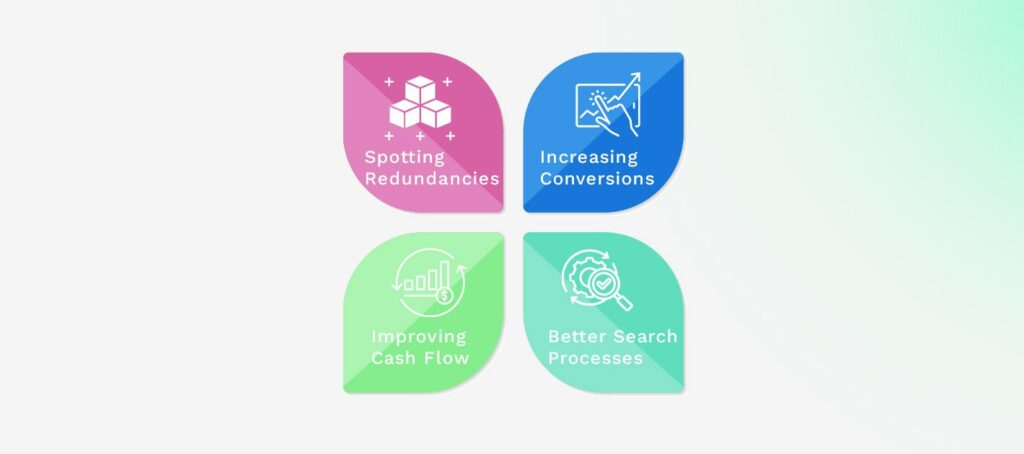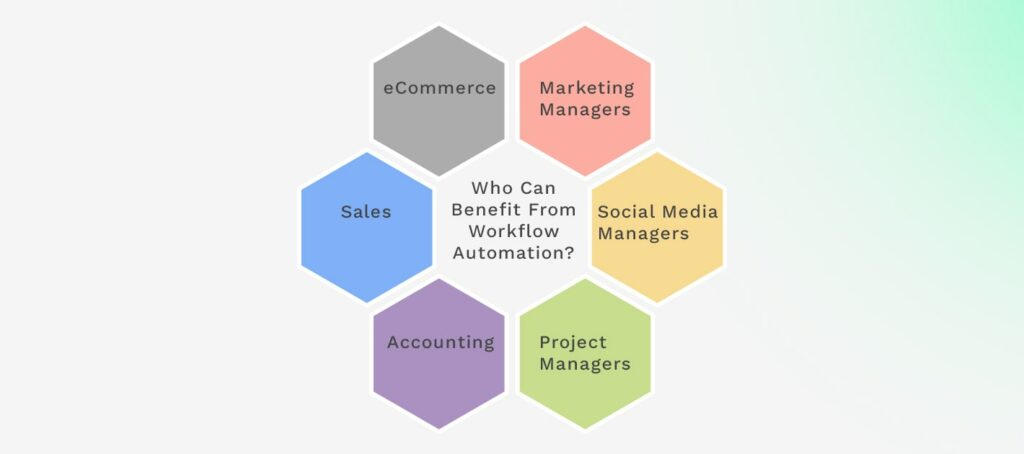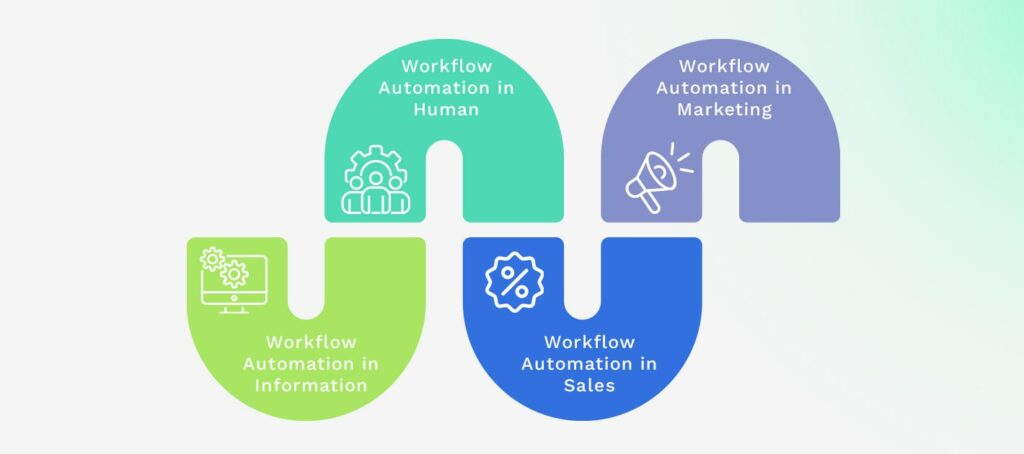Manual data entry is possibly one of the dullest and most inefficient tasks in the working world. Not only is it tedious, but it also wastes valuable time and resources, resulting in low productivity. According to Kore.ai's latest Employee Experience Benchmark Report, workers spend up to half of their day (about 3 to 4 hours) doing tasks that aren't productive or could be done automatically.
Fortunately, there's a solution to these redundant tasks that eliminates human error and lets you focus on the work that matters. Introducing workflow automation. This article will explain what workflow automation is, why it is important, and give you a step-by-step guide on how to create an automated workflow.
We'll buid your first application for you. At no extra cost.
Let us build your first business application for free. Go from an idea to an application in under 2 weeks.

What is Workflow Automation?
Workflow refers to the series of steps or tasks that need to be completed to achieve a specific goal or complete a process. It's like a roadmap that guides how work gets done, from start to finish.
What is Automation?
Automation is the technology by which a process or procedure is performed with minimal human assistance. It's the creation and application of technologies to produce and deliver goods and services with efficiency and precision. In the wider context, it plays a fundamental role in reducing the manual burden of repetitive and often monotonous tasks.
Automation in business can streamline operations, ensuring that everything from customer service to inventory management operates more smoothly and reliably. It leverages software, machines, and other technology to carry out tasks that would otherwise require a lot of time and human labor.
What is Workflow Automation?
Workflow automation combines the ideas of workflow and automation. It's about using technology to streamline and simplify the steps in a workflow by automating repetitive tasks. This helps to save time, reduce errors, and make processes more efficient. In other words, an automated workflow is a technology that uses rule-based logic to automate manual work, like data entry and lead nurturing.
Why is Workflow Automation Important?
Almost every business unit can benefit from workflow automation, whether it's marketing, human resources, or finance. It helps a company save time and money, increase productivity, and reduce human errors. Automated workflows also help you track completed tasks, so you know each employee's liability. Removing finished tasks from a teammate's daily to-do list can also help improve job satisfaction because they can focus on more strategic tasks.
These are only some of the reasons why you should learn how to create an automated workflow.
- Spotting Redundancies: Workflow automation helps identify and eliminate redundant tasks within a process. It enables businesses to pinpoint duplicated or unnecessary tasks, streamlining the process and making it more efficient. This saves time and reduces the chances of errors occurring when tasks are repeated manually. Identifying redundancies allows organizations to optimize their workflows, ensuring that resources are allocated effectively and productivity is maximized.
- Increasing Conversions: 77% of marketers report higher conversion rates from automating repetitive tasks like lead nurturing, follow-up emails, or customer outreach. This proactive approach helps businesses ensure timely and personalized communication with potential customers, build stronger relationships, and guide prospects through the sales funnel more efficiently. Automation also enables businesses to track customer interactions and preferences more effectively, allowing for targeted marketing efforts that are more likely to resonate with their audience and drive conversions.
- Improving Cash Flow: Automating financial tasks like invoicing, bill payments, and collections ensures that cash moves through the company efficiently. It minimizes delays, reduces the scope for human error, and speeds up the time to receive payment from customers. Automating the financial workflows enables organizations to free up capital from being stuck in the accounts receivable process for too long and better predict their financial standing with accurate, up-to-date records.
- Better Search Processes: Efficient search processes are critical for businesses to quickly access the right information at the right time. Workflow automation can significantly improve search functionality, allowing employees to find the documents, data, and resources they need without the hassle of sifting through piles of paper or unorganized digital archives. This promotes a more productive and less frustrating work environment, enabling teams to focus on value-adding activities.

Who Can Benefit From Workflow Automation?
Marketing Managers
77% of marketing professionals already use automation to simplify their tasks and for a good reason. Workflow automation in marketing ensures that every campaign runs smoothly and efficiently. It empowers marketing managers to design and execute complex marketing strategies with precision and minimal manual intervention. Marketing managers especially benefit from the increased visibility into campaign performance, which can guide resource allocation and improve ROI. Workflow automation thus becomes an essential factor in driving both the creative and analytical aspects of marketing.
Social Media Managers
Workflow automation can help social media managers transform the way they interact with audiences and manage content across platforms. This is why over 80% of marketing departments use automation for social media post scheduling and 58% automate the management of social media ads. It helps them maintain a consistent online presence without having to be glued to their screens at all times. Workflow automation is Ideal for social media managers who juggle multiple tasks and platforms daily, enabling them to free up creative energy and scale their social media efforts effectively.
Project Managers
Project managers have to manage numerous tasks, deadlines, and team dynamics, so integrating automation into their workflows can be very beneficial. Automating workflows enables them to delegate routine tasks, automatically sync up team members, use predictive analytics to foresee potential bottlenecks, and keep all project documentation organized and accessible. This helps improve team productivity and project delivery times, enabling project managers to meet their goals with greater ease and precision.
Accounting
The repetitive nature of many accounting tasks makes this sector ripe for the accuracy and speed benefits of automation. Key advantages for accounting include automated invoicing, expense tracking, financial reporting, payroll processing, and tax compliance. Automating workflows enables accounting departments to reduce manual errors, save time on routine operations, and focus on more strategic financial planning and analysis.
Sales
Automating aspects of the sales process can significantly improve productivity, allowing sales professionals to concentrate on selling rather than on administrative tasks. The sales force stands to benefit remarkably from automation via lead management, sales pipeline visualization, quote and proposal creation, activity logging, and performance analytics. Sales teams will value the time saved on data entry, the improved accuracy of their pipelines, and the ability to respond faster to customer needs, all resulting in a potential increase in sales performance.
eCommerce
eCommerce businesses handle an array of operations from inventory management to customer service, and automation can simplify these processes significantly. Some of the most important benefits of workflow automation for eCommerce include automated order processing, customer support, inventory management, review requests, and retargeting campaigns. eCommerce businesses will especially appreciate the scalability that automation provides, allowing them to grow their operations efficiently while maintaining a high level of customer satisfaction.

Workflow Automation Examples
Workflow Automation in Information Technology (IT)
Workflow automation can significantly enhance the efficiency and responsiveness of IT departments. Automating IT processes like ticketing systems, patch management, backup scheduling, and network monitoring can lead to a more proactive approach to system maintenance and issue resolution. Workflow automation enables IT to quickly adapt to technological changes, resolve issues faster, and maintain system security with less manual planning and tracking.
Workflow Automation in Human Resources (HR)
Workflow automation can help HR teams by simplifying the complexity of managing employee data and processes. Nearly 70% of HR professionals using automation in recruiting said it made the process much faster, while HR automation for onboarding resulted in an 18% improvement in performance. Workflow automation helps HR professionals significantly reduce their administrative workload, allowing them to focus more on strategic tasks and employee engagement.
Workflow Automation in Sales
Sales workflow automation helps reduce the burden of routine tasks, allowing sales professionals to concentrate on what they do best: sell. Automated tasks in sales include lead prioritization, email campaigns, sales pipeline updates, meeting scheduling, reporting and analytics, and more.
Sales workflow automation helps in turning cold leads hot, keeping the pipeline flowing, and ultimately ensuring that the most promising prospects are nurtured into customers. Ultimately, employing automated systems leads to a marked improvement in productivity and revenue.
Workflow Automation in Marketing
Marketing managers utilizing workflow automation find they can deliver more personalized, timely content that resonates with their audience, ultimately increasing engagement and conversion rates. Strategic automation in marketing includes drip campaigns, social media scheduling, lead nurturing, event-triggered emails, and analytics and adaptation.

How to Automate Your Workflows With Kohezion?
Choose a Workflow to Automate
For starters, find one everyday workflow you want to automate. Ideally, it will be repetitive, reasonably frequent, and have simple routing rules. The ideal candidates are processes that involve data entry, task assignments, notifications, or any activity that follows a predictable pattern.
Create a Visual Representation of Your Workflow
You can make these visual representations as workflow maps, charts, or diagrams. You would want to do this before starting the automation process. Creating a workflow diagram helps you and your team understand the process from start to finish, identifying each task that needs to be completed and who is responsible for it.
Determine User Needs
Depending on the workflow you choose, you should also include the needs of those who regularly use it. For example, if you're automating a workflow for inactive contacts, you'll want feedback from the sales and the marketing team, the two departments that will likely use it the most. Show them a workflow diagram you just made so they can easily visualize the process and provide feedback.
Digitalize the Workflow
For this step, you can use your online database platform for the specific workflow automation software. Modern platforms like Kohezion are highly visual and easy to use. Business users can automate workflows using simple drag-and-drop tools. Some features in your Kohezion account include reports, online forms, calendars, collaboration tools, email notifications, pivot tables, and so on.
The basic package allows you to create an unlimited number of custom business applications. This means you can integrate your database with business processes and take advantage of workflow automation. It will eliminate mundane, repetitive tasks typical of all small businesses.
Test the Performance
Be sure to test the automated workflow system before fully committing to it. Testing your automated workflow is the best way to measure its efficiency, discover any errors, and optimize its performance. Make trial runs for the teams who will use the workflow the most and ask them for feedback.
Launch and Monitor
Once you're done designing and gathering the user input of the created automated workflow, you are ready for the launch. However, your work doesn’t stop here. Monitoring the workflow post-launch is critical to ensure that it continues to function as intended and brings about the desired improvements.
Conclusion
An automated workflow is crucial for enterprises that want to upgrade their business processes and be more efficient. It allows for better productivity and search processes, improves cash flow, increases conversions, and saves time and money.
By now, you should be ready to start automating your workflows. Even relatively small organizations can eliminate manual work and automate everyday tasks thanks to affordable, cloud-based solutions like Kohezion. It provides useful features to integrate your database with how your business works without the need for expensive programmers.
Start building with a free account
Frequently Asked Questions
The best workflow automation tool should be easy to use, allowing users to create and manage automated workflows without extensive technical expertise. It should also be able to automate a wide range of tasks, from simple repetitive processes to complex multi-step workflows, thus improving efficiency across different aspects of the business.
Compatibility with existing systems and software is essential to ensure seamless integration and smooth operation within the organization's technological ecosystem. Lastly, the tool should provide significant value for its cost, offering a favorable ROI for businesses of all sizes.
Yes, small businesses can benefit from high-end automation tools. These tools allow smaller enterprises to compete with larger ones by enhancing efficiency, reducing errors, and saving time. Automation also paves the way for future growth without a proportional increase in overhead.
To measure the ROI of a workflow automation tool, calculate the time and cost savings from reduced manual effort and error rates against the investment in the tool. Factor in improved employee productivity, customer satisfaction, and quicker turnaround times for a more comprehensive assessment.
Yes, it is possible to migrate from one workflow tool to another with minimal disruption. This can be done by planning carefully, executing the migration in stages, ensuring thorough testing, and training users ahead of the switch to avoid a steep learning curve once the new system is in place.

